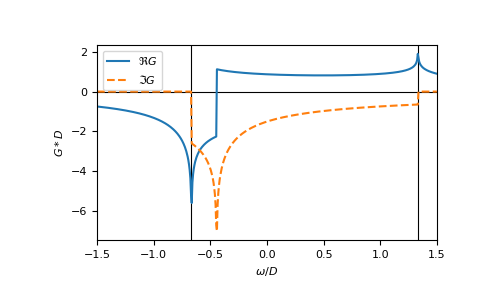gftool.lattice.triangular.gf_z¶
-
gftool.lattice.triangular.gf_z(z, half_bandwidth)[source]¶ Local Green’s function of the 2D triangular lattice.
Note, that the spectrum is asymmetric and in \([-2D/3, 4D/3]\), where \(D\) is the half-bandwidth. The Green’s function is evaluated as complete elliptic integral of first kind, see [horiguchi1972].
- Parameters
- zcomplex np.ndarray or complex
Green’s function is evaluated at complex frequency z.
- half_bandwidthfloat
Half-bandwidth of the DOS of the triangular lattice. The half_bandwidth corresponds to the nearest neighbor hopping \(t=4D/9\).
- Returns
- gf_zcomplex np.ndarray or complex
Value of the triangular lattice Green’s function
References
- horiguchi1972
Horiguchi, T., 1972. Lattice Green’s Functions for the Triangular and Honeycomb Lattices. Journal of Mathematical Physics 13, 1411–1419. https://doi.org/10.1063/1.1666155
Examples
>>> ww = np.linspace(-1.5, 1.5, num=500, dtype=complex) + 1e-64j >>> gf_ww = gt.lattice.triangular.gf_z(ww, half_bandwidth=1)
>>> import matplotlib.pyplot as plt >>> _ = plt.axhline(0, color='black', linewidth=0.8) >>> _ = plt.axvline(-2/3, color='black', linewidth=0.8) >>> _ = plt.axvline(+4/3, color='black', linewidth=0.8) >>> _ = plt.plot(ww.real, gf_ww.real, label=r"$\Re G$") >>> _ = plt.plot(ww.real, gf_ww.imag, '--', label=r"$\Im G$") >>> _ = plt.ylabel(r"$G*D$") >>> _ = plt.xlabel(r"$\omega/D$") >>> _ = plt.xlim(left=ww.real.min(), right=ww.real.max()) >>> _ = plt.legend() >>> plt.show()
